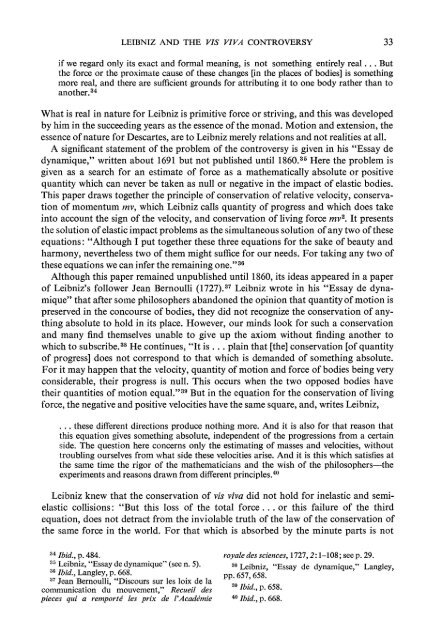Leibniz and the Vis Viva Controversy
Leibniz and the Vis Viva Controversy
Leibniz and the Vis Viva Controversy
Create successful ePaper yourself
Turn your PDF publications into a flip-book with our unique Google optimized e-Paper software.
LEIBNIZ AND THE VIS VIVA CONTROVERSY 33<br />
if we regard only its exact <strong>and</strong> formal meaning, is not something entirely real ... But<br />
<strong>the</strong> force or <strong>the</strong> proximate cause of <strong>the</strong>se changes [in <strong>the</strong> places of bodies] is something<br />
more real, <strong>and</strong> <strong>the</strong>re are sufficient grounds for attributing it to one body ra<strong>the</strong>r than to<br />
ano<strong>the</strong>r.34<br />
What is real in nature for <strong>Leibniz</strong> is primitive force or striving, <strong>and</strong> this was developed<br />
by him in <strong>the</strong> succeeding years as <strong>the</strong> essence of <strong>the</strong> monad. Motion <strong>and</strong> extension, <strong>the</strong><br />
essence of nature for Descartes, are to <strong>Leibniz</strong> merely relations <strong>and</strong> not realities at all.<br />
A significant statement of <strong>the</strong> problem of <strong>the</strong> controversy is given in his "Essay de<br />
dynamique," written about 1691 but not published until 1860.35 Here <strong>the</strong> problem is<br />
given as a search for an estimate of force as a ma<strong>the</strong>matically absolute or positive<br />
quantity which can never be taken as null or negative in <strong>the</strong> impact of elastic bodies.<br />
This paper draws toge<strong>the</strong>r <strong>the</strong> principle of conservation of relative velocity, conserva-<br />
tion of momentum mv, which <strong>Leibniz</strong> calls quantity of progress <strong>and</strong> which does take<br />
into account <strong>the</strong> sign of <strong>the</strong> velocity, <strong>and</strong> conservation of living force mV2. It presents<br />
<strong>the</strong> solution of elastic impact problems as <strong>the</strong> simultaneous solution of any two of <strong>the</strong>se<br />
equations: "Although I put toge<strong>the</strong>r <strong>the</strong>se three equations for <strong>the</strong> sake of beauty <strong>and</strong><br />
harmony, never<strong>the</strong>less two of <strong>the</strong>m might suffice for our needs. For taking any two of<br />
<strong>the</strong>se equations we can infer <strong>the</strong> remaining one."36<br />
Although this paper remained unpublished until 1860, its ideas appeared in a paper<br />
of <strong>Leibniz</strong>'s follower Jean Bernoulli (1727).37 <strong>Leibniz</strong> wrote in his "Essay de dyna-<br />
mique" that after some philosophers ab<strong>and</strong>oned <strong>the</strong> opinion that quantity of motion is<br />
preserved in <strong>the</strong> concourse of bodies, <strong>the</strong>y did not recognize <strong>the</strong> conservation of any-<br />
thing absolute to hold in its place. However, our minds look for such a conservation<br />
<strong>and</strong> many find <strong>the</strong>mselves unable to give up <strong>the</strong> axiom without finding ano<strong>the</strong>r to<br />
which to subscribe.338 He continues, "It is ... plain that [<strong>the</strong>] conservation [of quantity<br />
of progress] does not correspond to that which is dem<strong>and</strong>ed of something absolute.<br />
For it may happen that <strong>the</strong> velocity, quantity of motion <strong>and</strong> force of bodies being very<br />
considerable, <strong>the</strong>ir progress is null. This occurs when <strong>the</strong> two opposed bodies have<br />
<strong>the</strong>ir quantities of motion equal."39 But in <strong>the</strong> equation for <strong>the</strong> conservation of living<br />
force, <strong>the</strong> negative <strong>and</strong> positive velocities have <strong>the</strong> same square, <strong>and</strong>, writes <strong>Leibniz</strong>,<br />
. . . <strong>the</strong>se different directions produce nothing more. And it is also for that reason that<br />
this equation gives something absolute, independent of <strong>the</strong> progressions from a certain<br />
side. The question here concerns only <strong>the</strong> estimating of masses <strong>and</strong> velocities, without<br />
troubling ourselves from what side <strong>the</strong>se velocities arise. And it is this which satisfies at<br />
<strong>the</strong> same time <strong>the</strong> rigor of <strong>the</strong> ma<strong>the</strong>maticians <strong>and</strong> <strong>the</strong> wish of <strong>the</strong> philosophers-<strong>the</strong><br />
experiments <strong>and</strong> reasons drawn from different principles.40<br />
<strong>Leibniz</strong> knew that <strong>the</strong> conservation of vis viva did not hold for inelastic <strong>and</strong> semi-<br />
elastic collisions: "But this loss of <strong>the</strong> total force ... or this failure of <strong>the</strong> third<br />
equation, does not detract from <strong>the</strong> inviolable truth of <strong>the</strong> law of <strong>the</strong> conservation of<br />
<strong>the</strong> same force in <strong>the</strong> world. For that which is absorbed by <strong>the</strong> minute parts is not<br />
34Ibid., p. 484.<br />
35 <strong>Leibniz</strong>, "Essay de dynamique" (see n. 5).<br />
36 Ibid., Langley, p. 668.<br />
37 Jean Bernoulli, "Discours sur les loix de la<br />
communication du mouvement," Recueil des<br />
pieces qui a remporti les prix de l'Academie<br />
royale des sciences, 1727, 2: 1-108; see p. 29.<br />
38 <strong>Leibniz</strong>, "Essay de dynamique," Langley,<br />
pp. 657, 658.<br />
39 Ibid., p. 658.<br />
40 Ibid., p. 668.
















